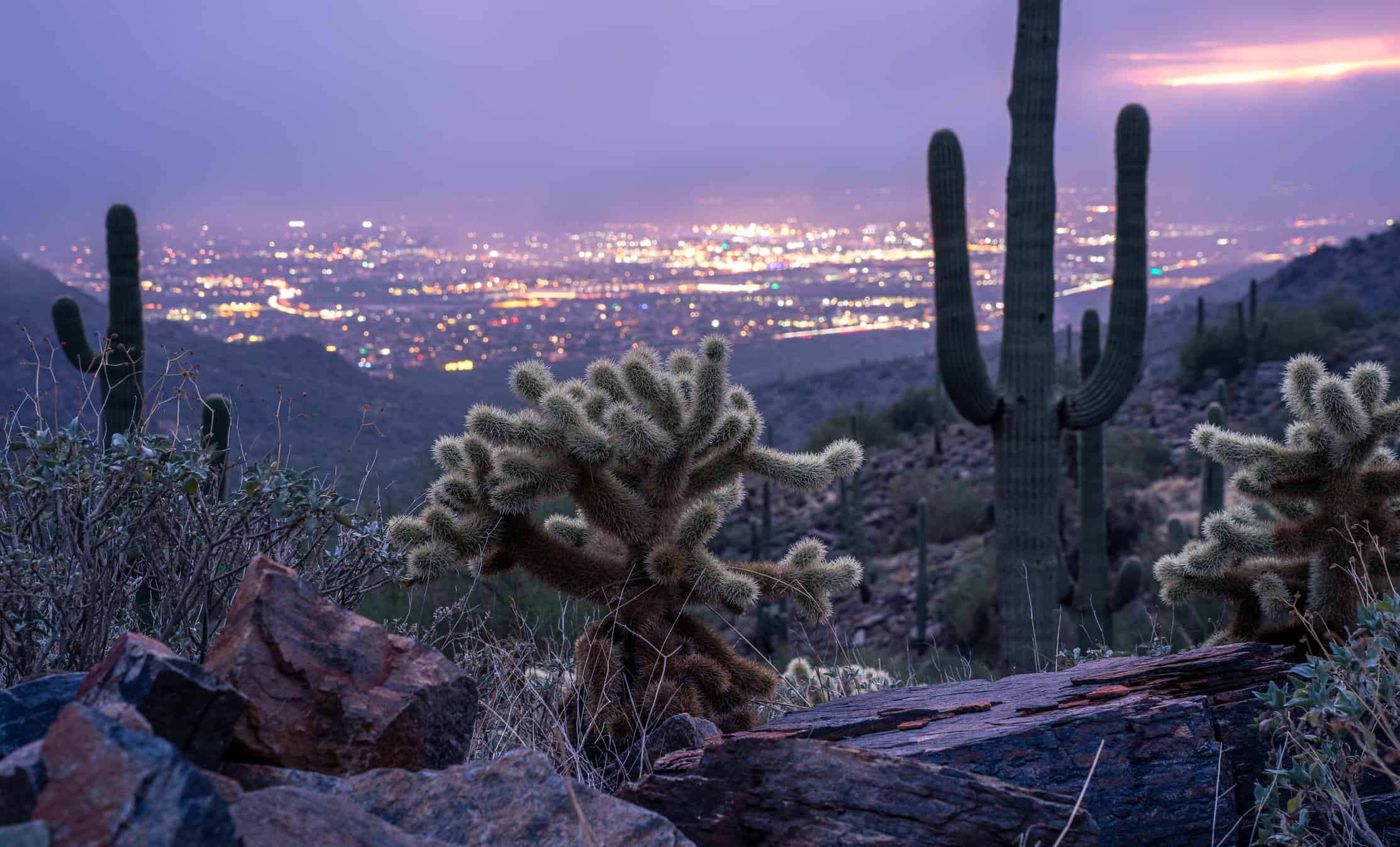A cactus is a type of succulent plant that stores water in its thick stems and leaves and has spines or spikes to protect itself from predators. Cacti are native to many parts of the world, including Arizona, which is home to more than 50 species of cacti, such as barrel cactus, cholla, pincushion cactus, and saguaro. People love planting these prickly plants as outdoor ornamentals because they provide unique texture and form to landscape designs while also being low-maintenance since they don’t require much water or fertilizer. In addition, some species feature beautiful flowers in shades of yellow, pink, and red that add a splash of color to any garden.
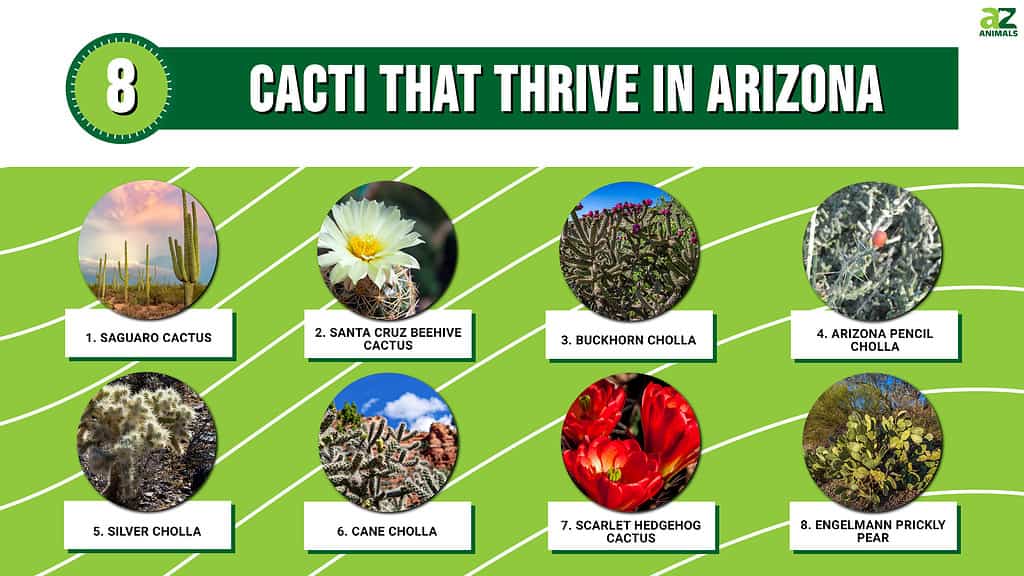
Growing Cacti in Arizona
Arizona is located in USDA Hardiness Zones 4b through 10b, depending on the region and elevation. Generally speaking, Zone 5 is found at higher elevations in Arizona’s mountain ranges like Flagstaff and the White Mountains, while Zones 6-10 are present throughout most of the state. This makes cacti an ideal plant choice for many areas in Arizona, as they tend to thrive best within these hardiness zones. Cacti can add a unique aesthetic to any garden or outdoor space due to their spiny characteristics and a wide variety of shapes and sizes. Additionally, they require minimal care, which makes them an attractive option for those who do not have the time or resources to devote large amounts of effort to gardening.
8 Types of Cacti
In Arizona, cacti species are abundant. From the low desert to the high mountains, you will find many unique varieties of cacti adapted to survive in each zone’s climate. We will break out the details of our favorite cacti to grow in Arizona, so you can be sure to select the correct plant for your garden.
1. Saguaro

The saguaro cactus can grow up to 40 feet and live for over 200 years.
©iStock.com/Nate Hovee
The saguaro cactus (Carnegia gigantia) is an iconic symbol of the deserts of the American Southwest, particularly Arizona. It can grow up to 40 feet and live for over 200 years! Its thick ribbed stems protect it from heat during the summer and cold temperatures in winter. The bright white flowers bloom at night in springtime, attracting pollinators such as bats, hummingbirds, and moths. The saguaro also produces a sweet edible red fruit that has been harvested by Native Americans for centuries as a source of food. Not only is this species important ecologically, but it is also culturally significant — it appears regularly in traditional art and literature of Indigenous peoples like the Tohono O’odham Nation, who have inhabited its habitat since time immemorial.
2. Santa Cruz Beehive Cactus
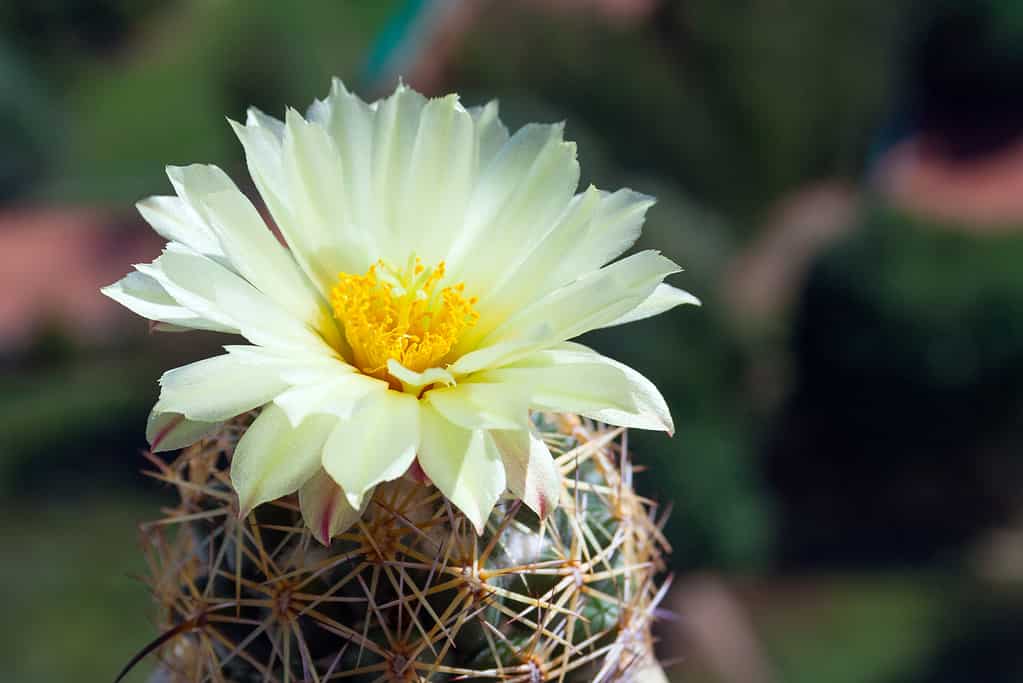
The beehive cactus blooms between May and June, producing large clusters of showy flowers at the top of its crowns that attract pollinators.
©iStock.com/Mikhail Strogalev
Coryphantha recurvata, also known as the Santa Cruz beehive cactus, is a species of cactus found in Arizona and northern Mexico. It typically grows to about 12 inches tall and can have up to 30 ribs. The stems are cylindrical or barrel-shaped with tubercles that give it its distinctive beehive look. Its spines are yellowish-brown to reddish-brown and curved downwards from the stem’s surface. The flowers of this cactus vary in color depending on the season, ranging from pink to white or yellow. This plant blooms between May and June, producing large clusters of showy flowers at the top of its crowns that attract pollinators like bees and butterflies. Additionally, Coryphantha recurvata is drought tolerant, so watering is generally not necessary once established in a garden or landscape setting.
3. Buckhorn Cholla
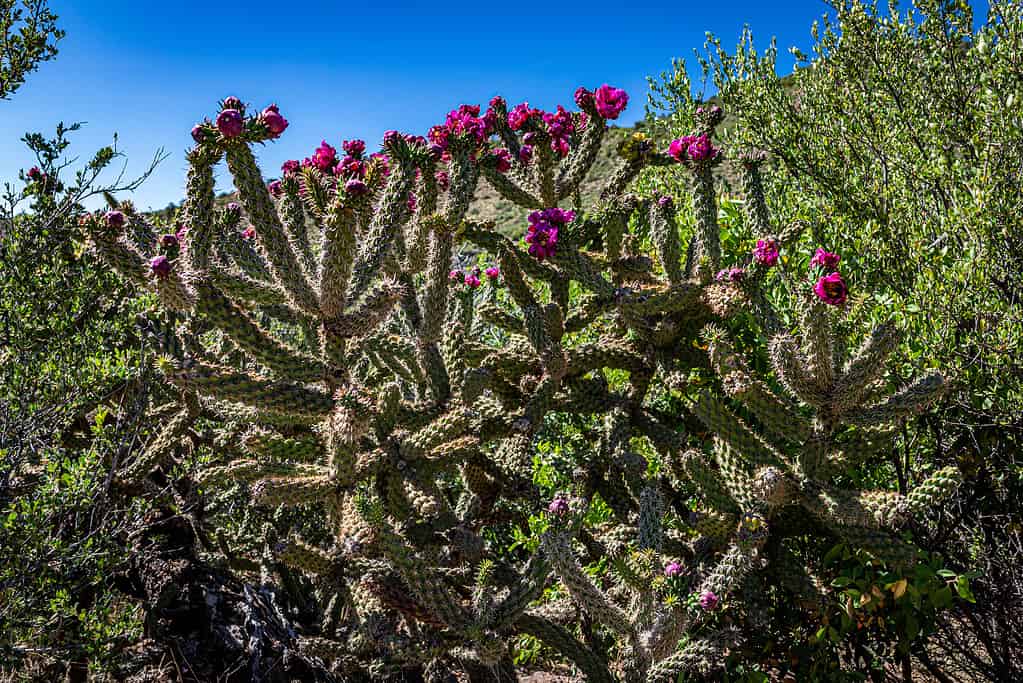
, also known as buckhorn cholla, is native to Arizona’s Sonoran Desert and grows up to 9 feet in height.
©iStock.com/Different_Brian
Cylindropuntia acanthocarpa, commonly known as buckhorn cholla, is a species of cactus native to the Sonoran Desert in Arizona. It is usually found on dry hillsides and deserts below 4,000 feet. The plant grows up to 9 feet tall with thick cylindrical branches covered with sharp spines. Its flowers are yellowish-green and consist of 5 petals that bloom during the summer months from May to August. Fruit can be produced between June and October if pollinated by insects such as bees or hummingbirds. The fruit is edible for humans but not particularly sweet or flavorful; it has been used traditionally by Native Americans for food in times of famine. Buckthorn cholla also serves an important role in providing habitat for other desert animals, such as birds and lizards, due to its dense foliage, which provides protection from predators and extreme temperatures. All in all, this unique cactus species plays an integral part in keeping the fragile desert ecosystem balanced!
4. Arizona Pencil Cholla
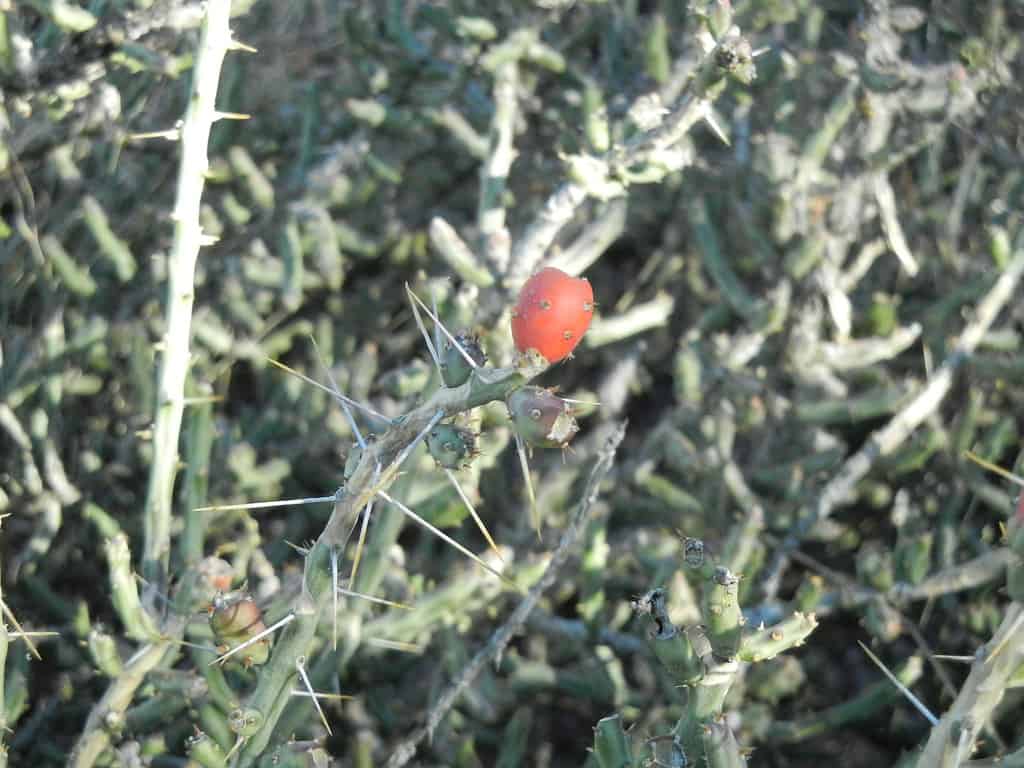
The Arizona pencil cholla has sharp thorns making it resilient against predators.
©Alice Wondrak-Biel, Public domain, via Wikimedia Commons – Original / License
Cylindropuntia arbuscula, more commonly known as Arizona pencil cholla, is a species of cholla cactus native to the Sonoran Desert. This type of cactus can reach heights up to 7 feet and can spread out over large areas through its cylindrical segments, which contain hundreds of hooked barbs. The flowers are usually small but have yellowish-green colors with red tips. The fruits are generally red or purple and contain several seeds. These plants prefer dry soil that has been exposed to direct sunlight for long periods of time and does not require much water or maintenance in order to thrive in the desert climate. They are also incredibly resilient against predators due to their sharp thorns, which deter most critters from taking bites out of them.
5. Silver Cholla

The silver cholla cactus has stems composed of segments equipped with sharp, silver spines.
©iStock.com/Nicholas Motto
Cylindropuntia echinocarpa, also known as the Silver cholla, is a species of cactus in the family Cactaceae. It is native to the deserts of Nevada, Arizona, and California in the United States. As its name suggests, it has silver spines that are dense and sharp. Its stems are composed of segments that can detach from each other easily, resulting in clumps that form around its base. The flowers appear between April and June and produce small edible fruit after pollination by bees or other insects. This species is drought tolerant but will grow best with plenty of sunlight and well-drained soil containing organic matter such as compost or manure. Overall, silver cholla makes an interesting addition to any desert garden!
6. Cane Cholla
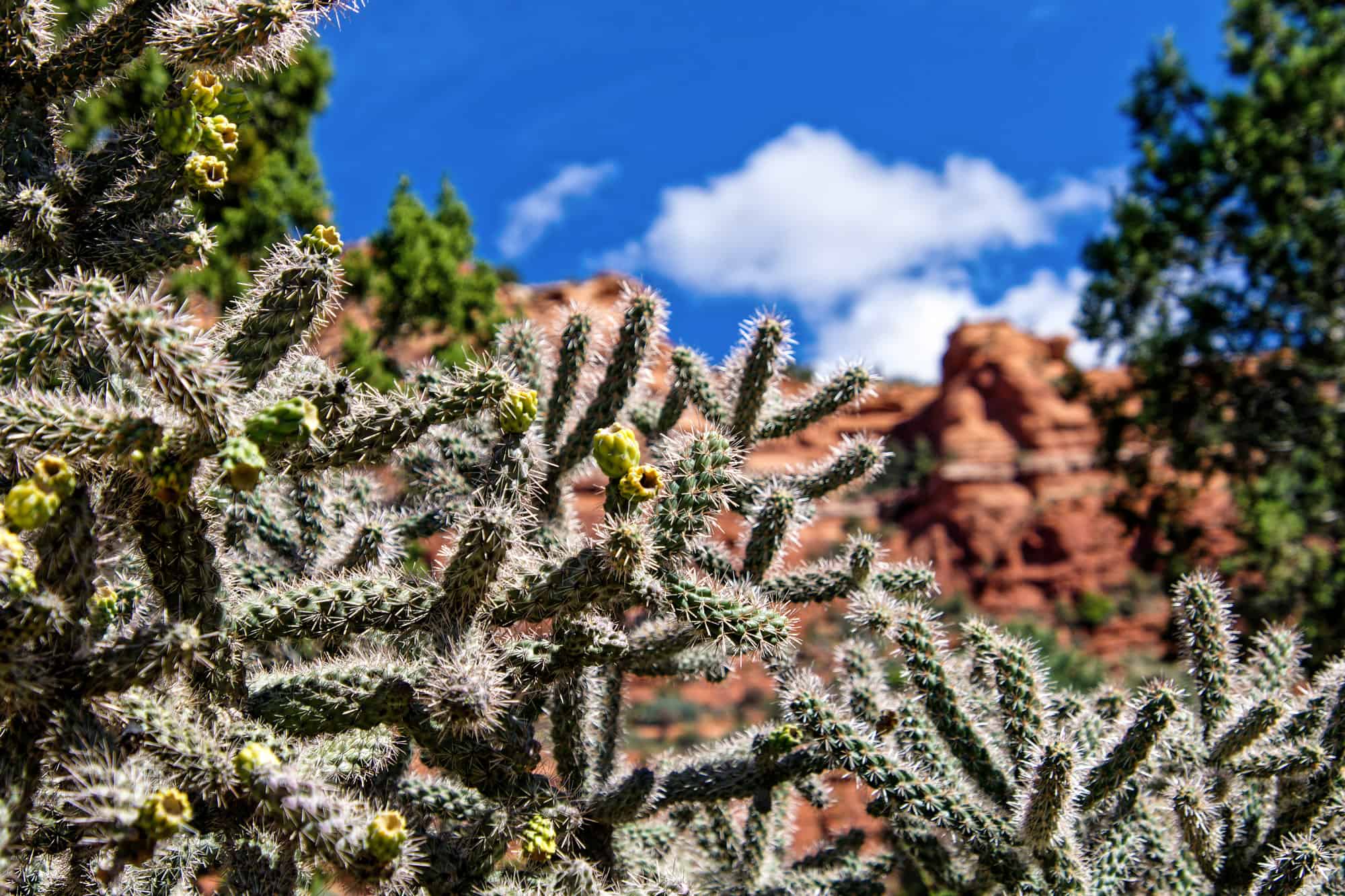
The cane cholla cactus is found in the desert areas of Arizona and can spread aggressively if given the opportunity.
©iStock.com/Wirestock
Cane cholla, also known as the Cylindropuntia spinosior, is a particularly spiny species of cactus that can be found in the desert areas of Arizona. It typically grows to be up to 4 feet tall and has cylindrical stems with yellow flowers blooming from April to June. The stems are covered by clusters of short spines which give it its signature look. This type of cactus requires minimal maintenance and can survive even in extreme climates due to its drought-tolerant nature. It is winter hardy to -10 degrees Fahrenheit! When compared with other types of chollas, cane cholla is considered more aggressive due to its large number of spines and ability to spread quickly across an area if given enough space or nutrients. Despite this fact, however, it remains a popular choice for landscaping due to its attractive appearance and hardiness against pests and diseases.
7. Scarlet Hedgehog Cactus
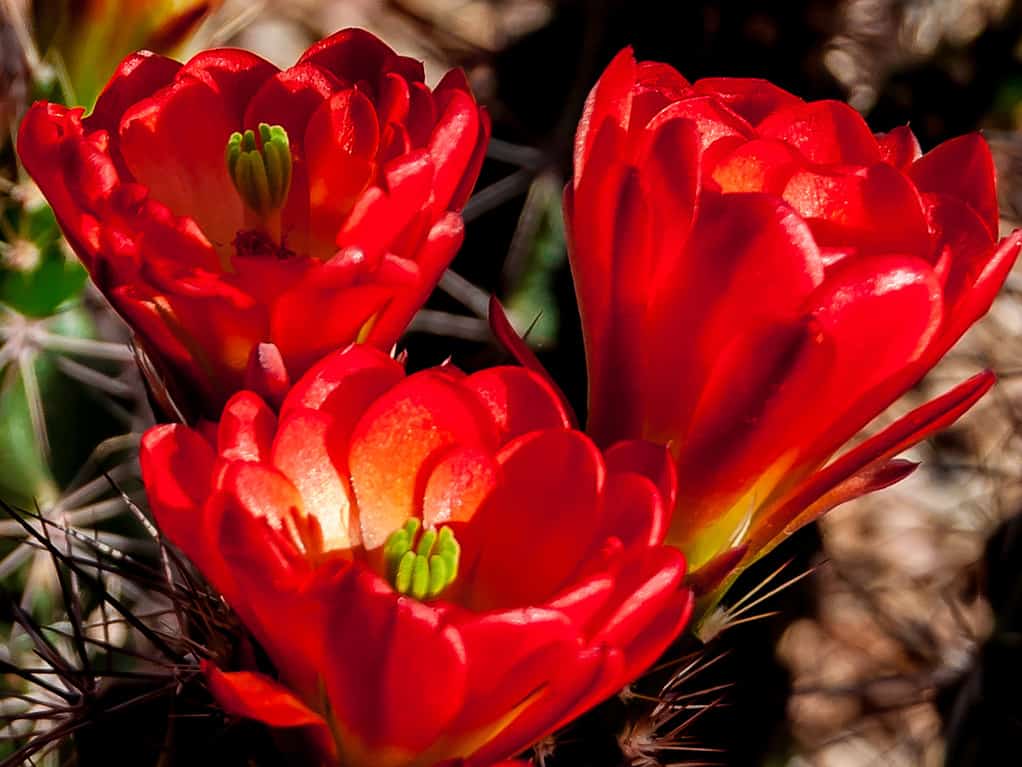
The scarlet
hedgehog
cactus produces bright red flowers and requires little water for survival, making it ideal for Arizona rock gardens.
©iStock.com/jherse16
The Echinocereus coccineus or scarlet hedgehog cactus is a member of the Cactaceae family and is native to Arizona. It typically grows on rocky slopes, cliffs, and crevices at elevations between 3300 – 9000 feet. This species has cylindrical stems that are usually solitary but may branch on older plants. They can grow up to 24 inches tall with 8-10 ribs per stem. The flowers appear in springtime and have bright red petals with yellowish stamens. The spines come in sets of four arising from each areole along the ribs of the stem, which gives it its namesake “hedgehog” appearance. Its fruit is green when immature turning yellowish brown as it matures, containing several small black seeds within a white pulp. As this species requires little water for survival, it makes an ideal choice for xeriscaping gardens or rock gardens in areas where rainfall is scarce, such as Arizona’s desert regions.
8. Engelmann Prickly Pear

, known as Engelmann prickly pear cactus, has thick cylindrical stems covered in small spines and yellow flowers.
©JHVEPhoto/Shutterstock.com
Opuntia engelmannii, commonly known as Engelmann prickly pear, is a species of cactus native to the Sonoran Desert region of Arizona. It can be identified by its thick cylindrical stems (pad) covered in small spines and yellow flowers that bloom from April through October. The pads are edible and can be used to make jams or jellies, while the flowers make a beautiful addition to salads or desserts! They also produce a fruit called tunas which is popular among locals for making syrup. Its scientific name honors George Engelmann, who was an American botanist and physician active in the mid-1800s in St. Louis, Missouri. This prickly pear grows best under desert conditions with direct sunlight and minimal water requirements, making it an excellent choice for xeriscaping projects or other arid climates.
Summary of 8 Types of Cacti That Thrive in Arizona
| # | Cactus Name | Scientific Name | Cactus Height | USDA Hardiness |
|---|---|---|---|---|
| 1 | Saguaro Cactus | Carnegia gigantia | 40 feet tall | Zones 8a-11b |
| 2 | Santa Cruz Beehive Cactus | Coryphantha recurvata | 12 inches tall | Zones 8-11 |
| 3 | Buckhorn Cholla | Cylindropuntia acanthocarpa | 9 feet tall | Zones 5-11 |
| 4 | Arizona Pencil Cholla | Cylindropuntia arbuscula | 7 feet tall | Zones 9a-11a |
| 5 | Silver Cholla | Cylindropuntia echinocarpa | 10 feet tall | Zones 9a-11b |
| 6 | Cane Cholla | Cylindropuntia spinosior | 4 feet tall | Zones 6a-10a |
| 7 | Scarlet Hedgehog Cactus | Echinocereus coccineus | 2 feet tall | Zones 9a-11b |
| 8 | Engelmann Prickly Pear | Opuntia engelmannii | 4-8 feet tall | Zones 9a-10 |
Thank you for reading! Have some feedback for us? Contact the AZ Animals editorial team.

